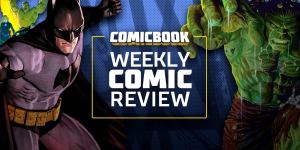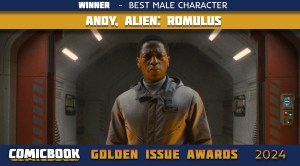
While it might be fair to judge a comic by its cover, an integral part of the issue and representation of the art, we often make the mistake of pre-judging comics on other topics like whether they’re licensed. If you’re unfamiliar, a licensed comic is any series or issue that is based on a pre-existing property owned by another entity and licensed to a comics publisher to produce new material. They often come with an unfair reputation of subpar quality, but there was one series this year that showed licensed comics are not just worthy of consideration, but can be some of the best on shelves at any given moment: Aliens: Dead Orbit.
Videos by ComicBook.com
Aliens: Dead Orbit was a new four-issue miniseries from creator James Stokoe (Godzilla: The Half-Century War, Orc Stain) published by Dark Horse in 2017. Unlike many of the Aliens comics published, it does not comment on the events of any of the films or build itself into the expanding mythos of Ridley Scott’s original creation. Instead, Stokoe tells a story with the familiar xenomorphs and technology from Alien and Aliens that is still entirely his own story. The mini-series is one of the best comics of 2017, and a perfect example of how licensed comics can match and possibly even exceed their source material.
Here’s why Aliens: Dead Orbit was the best licensed comic of 2017.

Capturing the Movies Perfectly
It’s impossible to read Aliens: Dead Orbit without acknowledging everything it gets just right from the source material. The most obvious examples lie within Stokoe’s aesthetics. Xenomorphs are an impressive construct in every panel in which they appear. His immensely detailed style and ability to provide pressure and texture to each individual line makes them as terrifying and alien as they would be in H.R. Geiger’s worst nightmares. The technology within the story is similarly detailed. Stokoe captures the blue collar feeling of both Alien and Aliens with the dirt, imperfections, and personal touches that pervade every new setting. Whether a sequence takes place in the sick bay or mess hall, it feels like a lived-in reality rather than an idealized vision of the future. While Stokoe’s style is as unique as ever, it affects the elements of the films incredibly well.
Stokoe also manages to embrace the tone of Alien in a truly striking fashion. When we think of the very first film in the franchise, a few keywords come to mind: horror, claustrophobia, gore, prey. Each of these are realized within the pages of Aliens: Dead Orbit. The crew of the ship are trapped with a pair of aliens, and every panel squeezes them into a truly terrifying nightmare. Tunnels and packed rooms fill the frame and make everything about the interior of their vessel feel small. Stokoe recognizes the incredibly creepy effects of air passages and makes the presence of these chitinous predators felt often without even showing their faces. While the tension builds across all four issues, there’s never a moment where anything feels OK. It is all a build to the next moment of horror, just like in the original film.

Perfecting the Formula for Comics
What really makes Aliens: Dead Orbit stand out isn’t that it reminds us of the movies from which it is derived, but that it makes the style and tone of those movies function within the comics form. Imitation is common in licensed comics with elements often mirroring favorite components from other media. It’s the transformation of those elements into something that works only within comics that allows a licensed work to transcend limitations.
Everything about the tone and feel of Alien remains in Aliens: Dead Orbit, but Stokoe manages to execute on those elements as only he possibly could. There’s one example at the end of issue one that is perfectly illustrative of this concept. The form of a xenomorph is seen emerging from steam only to be revealed as a collection of the ship’s inner workings unfortunately placed together. This one-two punch of tension and release is based entirely in artistic form, something that would be almost impossible to replicate in film. The illusion of art allows Stokoe to control the reader’s perspective and perception more precisely, making the page turns even more tense. It’s also what makes the very final page of the issue in which the alien finally emerges all the more frightening, as page turns prevent any anticipation of yet another reversal. It’s a brilliant series of panels that form something only possible in the pages of a comic book.

A Unique Work Without the License
The most important element of Aliens: Dead Orbit though is that it is a comic you could hand to someone who had never seen Alien, Aliens, or any of the lesser films within the franchise, and they would still enjoy it. This is a story that does not rely on its license to function, but provides a complete, immersive experience on its own. That should be no surprise given Stokoe’s prior work with the Godzilla license on “The Half-Century War”, but it is still impressive given the preconceptions of most licensed comics produced today.
Aliens: Dead Orbit riffs on story elements from the original franchise, but no more so than any of the sequels to the original films. There’s an unfortunate discovery in space, the growth cycle of xenomorphs, and finally a hunting sequence and countdown. It’s familiar, but Stokoe makes it his own in this story. If you were to expose someone to Aliens for the very first time with this comic, they would not be disappointed — even if Alien remains the best possible starting point.
Stokoe sets a high bar for licensed comics in Aliens: Dead Orbit. He displays a clear understanding of what makes the concept he’s handling popular, but more importantly he shows how it can work uniquely within the form of comics and why his story is worthy of unique attention outside of the original. Rather than worshipping at the shrine of something already popular, Aliens: Dead Orbit constructs a story that ought to be popular with or without that connection. That’s the true mark of success for any licensed comic.




